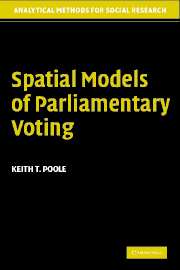Book contents
- Frontmatter
- Contents
- List of Tables and Figures
- Preface
- 1 Introduction
- 2 The Geometry of Parliamentary Roll Call Voting
- 3 The Optimal Classification Method
- 4 Probabilistic Spatial Models of Parliamentary Voting
- 5 Practical Issues in Computing Spatial Models of Parliamentary Voting
- 6 Conducting Natural Experiments with Roll Calls
- 7 Conclusion
- References
- Index
5 - Practical Issues in Computing Spatial Models of Parliamentary Voting
Published online by Cambridge University Press: 24 November 2009
- Frontmatter
- Contents
- List of Tables and Figures
- Preface
- 1 Introduction
- 2 The Geometry of Parliamentary Roll Call Voting
- 3 The Optimal Classification Method
- 4 Probabilistic Spatial Models of Parliamentary Voting
- 5 Practical Issues in Computing Spatial Models of Parliamentary Voting
- 6 Conducting Natural Experiments with Roll Calls
- 7 Conclusion
- References
- Index
Summary
Overview
A number of practical issues arise in the real-world estimation of spatial models. This chapter is unavoidably idiosyncratic, because it reflects my experience as a builder of computer programs that estimate spatial maps of legislative voting. There is usually more than one way to build a mousetrap, and the practical solutions I offer for problems that arise in estimating spatial models are not necessarily unique nor my exclusive creation. They have one thing going for them, however: They all work. They are the result of 30 years of experimentation in computer code. I have often found that theoretically elegant ways of doing certain tasks – for example, generating starting coordinates when there are missing data – did not work as well as simple “hacks.” Consequently, what I discuss below is the chewing gum and baling wire that lie underneath the hood of OC, QN, and NOMINATE.
Unlike the previous chapters, this chapter does not proceed in a nice linear fashion. I have grouped the topics so that similar ones are discussed together. The first section covers standardized measures of fit. I have dealt with this topic tangentially in Chapters 3 and 4 – OC maximizes correct classification, and probabilistic models maximize log-likelihood – but a short discussion is necessary for the remaining topics in the chapter and for the roll call experiments discussed in Chapter 6. The second topic is concerned with how to get reasonable starting values for the legislator ideal points.
Information
- Type
- Chapter
- Information
- Spatial Models of Parliamentary Voting , pp. 128 - 161Publisher: Cambridge University PressPrint publication year: 2005
